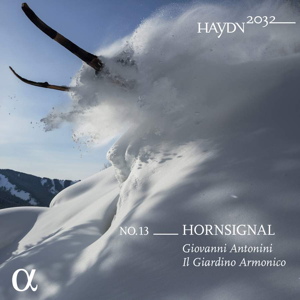
Franz Joseph Haydn (1732-1809)
Haydn 2032 No. 13
Symphony No. 31 in D Major ‘Hornsignal’
Symphony No. 59 in A Major ‘Fire’
Symphony No. 48 in C Major ‘Maria Theresia’
Il Giardino Armonico / Giovanni Antonini
rec. 2021, Euregio Kulturzentrum Gustav Mahler, Toblach (BZ), Italy
Alpha 692 [80:18]
Haydn 2032, an ongoing project to record Franz Joseph Haydn’s entire symphonic output by the 300th anniversary of his birth, has yielded some of the finest recordings of this repertoire since Nikolaus Harnoncourt’s reference set of the ‘Paris’ symphonies on Deutsche Harmonia Mundi in 2002. The high standard in evidence on volume 13, the first that I have heard in this series, has inspired me to follow the cycle. Committed playing by a first-rate period-instrument ensemble, observation of all the repeats marked by Haydn, and scrupulous attention to detail that conveys the unique character of each symphony earn this disc an important place in the Haydn discography.
Composed in 1765, Haydn’s Symphony No. 31 in D major, Hob. I: 31, acquired its soubriquet from the horn signals that recur throughout the work. Four horns, rather than the usual two, in Prince Nikolaus I. Joseph Esterházy’s orchestra of around 17 musicians create an unusual balance. The remainder of the scoring comprises one flute, two oboes, and strings (two violins, viola, cello, and bass). Giovanni Antonini and Il Giardino Armonico give a thrilling account in which the valveless horns emerge exuberantly from the instumental fabric. Antonini, thankfully, performs all of the repeats, which respects the structure and heightens the music’s emotional impact.
Symphony No. 59 in A Major, Hob.I: 59, dates to 1768 and bears the epithet ‘Fire’, which did not originate with Haydn. This four-movement work is scored for two oboes, two horns, continuo (bassoon, harpsichord) and strings. Antonini takes the first movement as a true ‘presto’, as per Haydn’s tempo indication, and keeps the pulse of the music throughout the symphony in comportment with the composer’s markings. As with the previous work on this disc, Antonini takes all of the repeats noted in the score and uses impeccable judgement regarding dynamics and articulation. This performance is the most satisfying period-instrument account on record and even surpasses Trevor Pinnock’s account (1989), which omits several of the repeats and does not convey as much passion as Antonini does.
The third symphony on this disc, No. 48 in C Major Hob. I: 48 from 1768 or 1769, received the title ‘Maria Theresia’ because it was assumed to have been associated with the Empress’s visit to the Esterházy palace in 1773. Antonini follows the original version of the symphony, which is scored for two oboes, bassoon, two horns, and strings. Trumpet and tympani parts, which were added later, are not by Haydn.
Complete cycles of Haydn’s 107 known symphonies are few. Antal Doráti’s monumental set with the Philharmonia Hungarica, recorded in the late 1960s and early 1970s (Decca 4485312), is one of the greatest achievements in this history of recorded sound. Decca should remaster these recordings and take advantage of the extended CD playing times of ca. 88 minutes to fit all of the contents in chronological order onto fewer discs than the current 33. An alternative in digital sound is Ádám Fischer’s cycle, recorded between 1987 and 2001 in the Haydnsaal of the Esterhazy Palace in Eisenstadt, with the Austro-Hungarian Haydn Orchestra (Brilliant Classics 99925).
Daniel Floyd
Help us financially by purchasing from




















